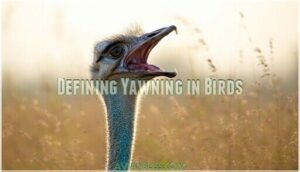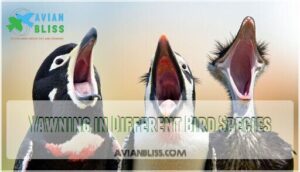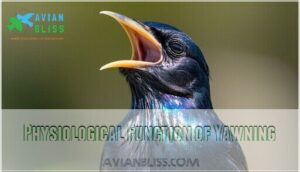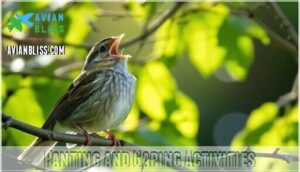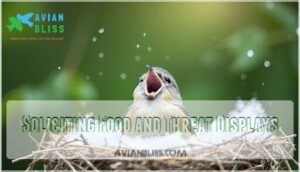This site is supported by our readers. We may earn a commission, at no cost to you, if you purchase through links.
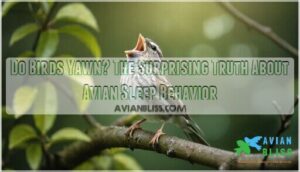
When birds open their beaks wide and stretch their necks, they’re performing what scientists call "gaping behavior."
This action serves multiple purposes: cooling their brains, preparing for sleep, and even communicating with other birds.
You’ll notice this behavior more often when birds are tired or stressed, similar to how you yawn when drowsy.
However, distinguishing true yawning from other behaviors like panting or food begging can be tricky.
The science behind why birds yawn reveals fascinating connections to their unique sleep patterns and how they prepare for rest, which is closely related to their brain cooling mechanisms and stress responses.
Table Of Contents
- Key Takeaways
- Do Birds Yawn?
- Defining Yawning in Birds
- Observations of Yawning Behavior
- Physiological Function of Yawning
- Controversy and Debate
- Distinguishing Yawning From Other Behaviors
- Frequently Asked Questions (FAQs)
- Is it normal for a bird to yawn?
- What does it mean when birds open their mouths?
- Do birds sneeze?
- What does it mean when a bird gags?
- Why do birds yawn when you rub their ears?
- Is it normal for birds to yawn?
- What animals don’t yawn?
- What does it mean when a bird opens its mouth at you?
- Which bird yawns?
- What does it mean when a bird yawns?
- Conclusion
Key Takeaways
- Birds do yawn, but it’s called "gaping behavior" – You’ll see them open their beaks wide and stretch their necks, though scientists debate whether this counts as true yawning since it doesn’t always involve deep breathing like human yawning does.
- Bird yawning serves multiple purposes – When you observe this behavior, they’re likely cooling their brains, regulating body temperature, preparing for sleep, or communicating with other birds, especially when they’re tired or stressed.
- You can distinguish yawning from other behaviors by watching the context – Don’t confuse genuine yawning with panting (rapid breathing when hot), food begging (young birds with open beaks), or threat displays, as the timing and accompanying body language will tell you the difference.
- The science behind bird yawning remains controversial – You should know that researchers still can’t agree on what constitutes true avian yawning, making it one of nature’s ongoing mysteries despite observations across dozens of bird species.
Do Birds Yawn?
Ever wondered if your feathered friends yawn like you do? Yes, birds absolutely yawn!
You’ll spot them opening their beaks wide in a stretching motion that mirrors human yawning. This bird behavior serves multiple purposes, from temperature regulation to social bonding.
While experts debate the exact evolutionary origins, avian yawn patterns reveal fascinating insights about animal yawning across species, including the role of temperature regulation.
Defining Yawning in Birds
When you think about bird yawning, you’re entering murky scientific waters.
You’re diving into one of nature’s most puzzling mysteries—do our feathered friends actually yawn?
Defining what counts as a true avian yawn isn’t straightforward, and experts can’t agree on the basics.
Traditional yawning involves opening your mouth wide while taking a deep breath.
But bird physiology works differently.
Birds have beaks, not jaws, and their comparative anatomy creates unique challenges.
Some researchers argue that genuine yawning reflex requires both the wide mouth opening and deliberate inhalation – something you’ll see in ostriches and a few other species.
However, many birds simply perform what scientists call an avian gape – stretching their beaks without the breathing component.
This defining characteristic separates true yawning from basic beak-stretching behavior.
The yawn function remains unclear, making bird behavior research particularly complex.
Without consensus on basic definitions, studying why birds yawn becomes nearly impossible.
Their respiratory system relies on efficient oxygen supply due to high metabolic needs.
Observations of Yawning Behavior
You’ll notice that birds open their beaks wide and stretch in ways that look remarkably similar to human yawning, but determining whether this behavior truly counts as yawning requires careful observation.
Researchers have documented these beak-stretching behaviors across dozens of bird species, from tiny hummingbirds to large eagles, though the frequency and triggers vary substantially between different types of birds.
Jaw-Stretching Vs. True Yawning
Telling the difference between jaw muscle stretching and true yawning isn’t easy when you’re watching birds.
You’ll notice cormorants stretch their beaks wide, but they’re not actually inhaling deeply like mammals do.
Real avian yawn involves airflow analysis and neurological control that triggers specific beak mechanics.
This muscle action distinction helps scientists understand evolutionary origins of bird yawning behavior.
Some species, like the Yellow-headed Caracaras, exhibit symbiotic tick-picking behaviors.
Yawning in Different Bird Species
Different bird species show varying yawning patterns.
Birds yawn differently across species – some stretch their beaks while others truly inhale, creating fascinating behavioral diversity.
Budgerigars demonstrate social yawning birds behavior, yawning three times more when paired. Penguins incorporate avian yawn into courtship rituals for bonding.
Ostriches, cormorants, and Brown Boobies display distinct jaw-stretching movements. Species yawning frequency varies substantially – some birds yawn twenty times daily while others rarely do.
Bird yawning species differences highlight how environmental yawning triggers affect various species differently. Some owners even buy avian yawn products to better understand their birds.
Physiological Function of Yawning
When you observe a bird opening its beak wide and taking what appears to be a deep breath, you’re witnessing a behavior that serves several important biological functions.
Scientists believe this action helps regulate brain temperature, increase oxygen flow, and maintain alertness levels in ways similar to human yawning.
Theories on Yawning’s Purpose
Scientists debate several compelling yawning theories for birds.
The Thermoregulation Theory suggests avian yawn behavior helps cool brain temperature through air intake.
Social Signaling proposes yawning communicates group coordination, offering an Evolutionary Advantage.
The Drowsiness Theory links yawning to fatigue management.
Most researchers believe bird yawning purposes involve Multiple Functions – temperature regulation, oxygen flow, and social communication working together in complex avian behavior patterns.
Relation to Sleep and Alertness
While theories explain why birds might yawn, the connection between avian yawn behavior and sleep patterns reveals fascinating insights.
Birds don’t just yawn from bird fatigue – it’s actually linked to their circadian rhythm and serves multiple purposes:
- Sleep Deprivation Response – Yawning frequency increases when birds lack adequate rest, functioning as alertness signals
- Circadian Rhythm Regulation – Helps synchronize internal clocks with environmental cues
- Restorative Function – Promotes oxygen flow during shifts between avian sleep and wakefulness
- Bird Alertness Enhancement – Boosts cognitive function when switching behavioral states
Controversy and Debate
You might expect scientists to agree on whether birds actually yawn, but experts remain divided on this seemingly simple question.
The debate centers on whether birds truly inhale during their beak-opening behavior, with researchers struggling to distinguish genuine yawning from similar actions like panting or gaping, which is a complex issue.
Lack of Consensus Among Experts
You’d think experts would agree on something as simple as defining yawn behavior, but they don’t.
Some researchers see avian yawning evidence in jaw-stretching, while others demand true inhalation.
These conflicting theories about yawn purpose and avian physiology create heated debates.
Research limitations prevent clear answers about yawning in avian behavior, leaving future directions wide open for discovery.
Challenges in Studying Avian Yawning
Studying avian yawn patterns turns out to be trickier than catching a bird with your bare hands. Researchers face multiple hurdles when defining yawning across different species.
- Species variation makes it hard to establish universal yawning criteria
- Environmental factors like temperature and social settings affect frequency
- Research methods must account for subtle behavioral differences between gaping and true yawns
- Ethical considerations limit invasive bird yawning experiments
- Why birds yawn remains unclear due to these methodological challenges
Sudden behavioral shifts may also complicate the data.
- Why birds yawn remains unclear due to these methodological challenges.
Sudden behavioral shifts may also complicate the data, and could indicate underlying health problems.
Distinguishing Yawning From Other Behaviors
You’ll often see birds opening their beaks wide, but this doesn’t always mean they’re yawning since many behaviors look similar.
Distinguishing true yawning from panting, gaping for temperature control, begging for food, or displaying threat signals requires careful observation of the context and accompanying body language.
Panting and Gaping Activities
You’ll often see birds gaping or panting when they’re hot, but don’t mistake this for yawning.
Panting involves rapid, shallow breaths for heat dissipation and avian thermoregulation. Watch for gular fluttering—that throat vibration helps cool them down.
The respiratory rate shoots up during stress or overheating. A true avian yawn looks completely different: slower, deeper bird breathing without the frantic pace.
Birds may also pant due to underlying respiratory issues.
Soliciting Food and Threat Displays
How can you tell if a bird’s gaping is yawning or something else entirely?
Young birds often display begging displays with wide-open beaks during food solicitation, while adults use threat postures as agonistic behavior.
Chickadee displays and courtship rituals also involve mouth-opening that mimics yawning.
Context matters—watch for accompanying body language to distinguish genuine yawning from bird communication and threat displays.
Frequently Asked Questions (FAQs)
Is it normal for a bird to yawn?
Like a sleepy child stretching awake, your feathered friend’s yawn is perfectly normal.
Birds yawn to regulate body temperature, increase alertness, and sometimes signal relaxation.
It’s their natural way of staying comfortable and alert.
What does it mean when birds open their mouths?
When you see birds opening their mouths, they’re likely yawning for temperature regulation or thermostat adjustment.
This behavior helps them cool down, increase alertness, clear their throats, or simply relax after preening sessions, which can be considered a form of relaxation.
Do birds sneeze?
Birds don’t sneeze like you do, but they’ll shake their heads, ruffle feathers, or make soft snorting sounds when dust or irritants bother their nostrils.
It’s their natural way of clearing airways.
What does it mean when a bird gags?
When your bird gags, it’s usually trying to dislodge something stuck in its throat or crop.
You’ll see head bobbing and beak opening, which is normal behavior.
It’s normal behavior, but watch for excessive gagging indicating potential blockages.
Why do birds yawn when you rub their ears?
Ever wonder why your feathered friend opens wide during ear rubs?
When you touch their ears, birds yawn because it triggers deep relaxation and pleasure responses, similar to how gentle touches make humans feel calm and content.
Is it normal for birds to yawn?
Yes, yawning is completely normal for your feathered friends.
They’ll yawn about twenty times daily to regulate body temperature, increase alertness, and clear their throats.
It’s just as natural as human yawning.
What animals don’t yawn?
Like puzzle pieces missing from nature’s yawning symphony, fish, reptiles, and most invertebrates don’t yawn.
You’ll find this behavior mainly in mammals and birds, leaving cold-blooded creatures out of this mysterious reflex altogether, which is a part of the yawning behavior.
What does it mean when a bird opens its mouth at you?
When your feathered friend opens its mouth at you, it’s likely yawning to regulate temperature or signal relaxation.
This behavior shows trust and comfort, though excessive mouth-opening might indicate stress or illness.
Which bird yawns?
Practically all птицы yawn! You’ll spot pigeons, parrots, cockatiels, budgerigars, crows, lovebirds, and ducks displaying this behavior.
From tiny hummingbirds to majestic eagles, every species opens their beaks wide and takes those telltale deep breaths, showcasing that every species exhibits this trait.
What does it mean when a bird yawns?
When your bird yawns, it’s usually regulating body temperature, increasing alertness, or signaling relaxation.
You might notice this after preening, when tired, or during social bonding with you or other birds.
Conclusion
Understanding whether birds yawn is like solving a puzzle with missing pieces.
While you’ve learned that birds do exhibit yawning-like behavior called gaping, the scientific community continues debating its true purpose and mechanisms.
You’ll now recognize that distinguishing genuine yawning from panting or food begging requires careful observation.
The next time you watch birds, you’ll appreciate the complexity behind their seemingly simple behaviors and understand why researchers remain fascinated by this avian mystery.

